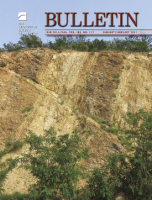“The San Diego Formation, Pico Formation, Careaga Sandstone, and Foxen Mudstone of southern California are thought to be late Pliocene to early Pleistocene; however, numerical ages have not been determined. Following assessment of diagenetic alteration via multiple methods including scanning electron microscopy (SEM), X–ray diffraction (XRD), and minor elemental concentrations, we attempted to use strontium isotope stratigraphy to assign numerical ages. Using aragonitic fossils, we obtained ages of 2.0–1.85 Ma for the Careaga Sandstone and 2.0–1.75 Ma for the uppermost Foxen Mudstone, consistent with biostratigraphic work suggesting a Gelasian age for the Careaga Sandstone. Isotope ratios for aragonitic and calcitic fossils from the Pico Formation were poorly constrained, with the exception of one bed yielding ages of 5.1–4.3 Ma. Isotope ratios from the San Diego Formation were also inconsistent within beds, with the exception of two isolated outcrops that yielded ages of 5.0–4.5 Ma and 4.5–2.8 Ma, respectively. The age estimates for the Pico and San Diego Formations are older than most ages inferred from biostratigraphy. Noting that some aragonitic specimens from the San Diego Formation yielded isotope ratios indicative of ages as old as 19.4 Ma, we propose that some outcrops have been affected by diagenesis caused by groundwater flow through proximal granitic rocks and input from detrital sediment. Although we recommend that strontium isotope results for the Pico and San Diego Formations be interpreted with caution, the ages of the uppermost Foxen Mudstone and Careaga Sandstone can be confidently placed within the early Pleistocene”
Read the article! (Gold Open Access: This paper is published under the terms of the CC-BY license)

